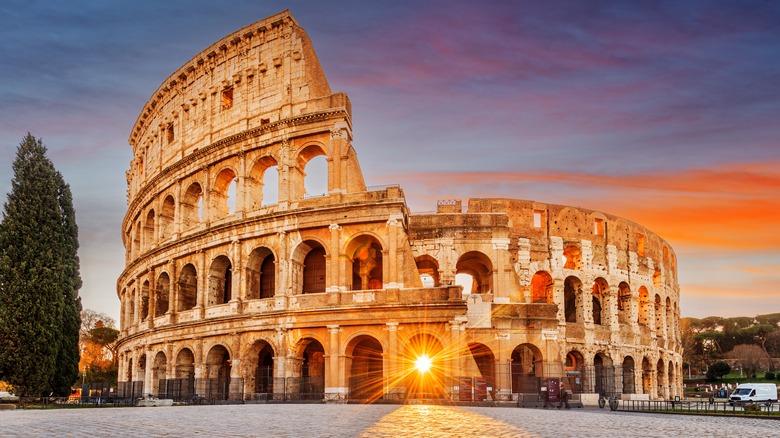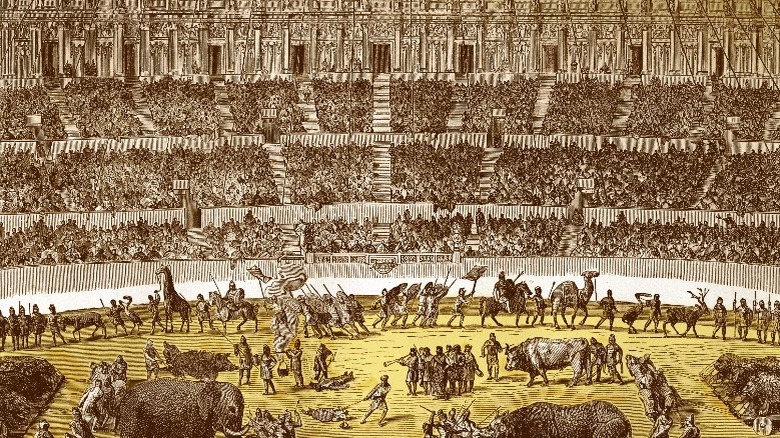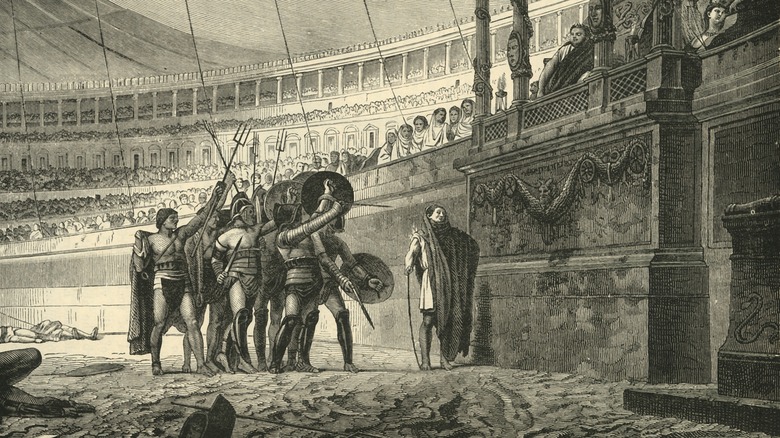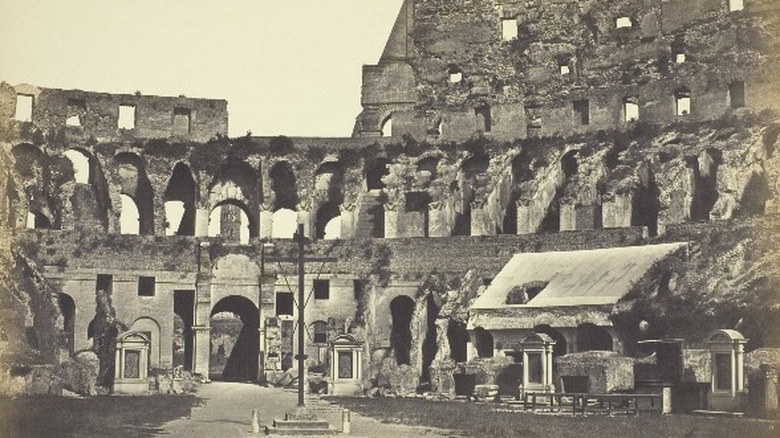Here's What Really Happened To The Missing Half Of The Colosseum
The Roman Colosseum may be virtually immortal, but it definitely looks its age. The nearly 2,000-year-old amphitheater was once nearly twice as large as it is today (via Rome City Tour). Since the very first gladiators were thrown into its bowels in the early centuries, the Colosseum has survived many calamities. The temperamental geography of the Earth's crust in Italy doesn't just extend to Pompeii. The great city of Rome — once the largest in the world for its time — has crumbled more than once. Once upon a time, an earthquake struck, and along with much of Rome, so went half the Colosseum.
But by that time, its legacy had already begun to crumble. In 2016, Rome was hit by an earthquake (via SciMex). It certainly wasn't the first time. In A.D. 443, an earthquake struck central Italy — the very same fault line had triggered the first crumblings of the Roman Colosseum and the Theater of Pompey nearly six centuries before that.
The Colosseum is nearly 2,000 years old
By 443, the Flavian Amphitheater (as the Colosseum was then called, named for the Flavian dynasty) had already existed longer than three and a half centuries — far longer than any surviving building in the United States. Construction began in A.D. 70 under Emperor Vespasian (via Art in Context), whose armies sacked Jerusalem. The Roman Army left with gold in tow, which they used to pay for the Colosseum. Many suspect that the Romans then forced their captives, newly-enslaved Jewish people, to build it. Stone complexes and gladiatorial areas were constructed encircling the area, which would soon be the hub of a vibrant first-century metropolis. Emperor Vespasian died in A.D. 79, and the Flavian Amphitheater was mostly completed one year later under the reign of his son Titus (although renovations continued for awhile).
From its opening night, the Colosseum flooded with Romans of nearly all classes. Their rulers fed 9,000 exotic animals to each other, hoping to evade the thirsty appetites of angry plebeians themselves. The Roman Empire's appetite for conquest and blood was no secret, and now they'd built a playground for their passions.
After a great fire ravaged much of the interior in 217, an earthquake struck in the fifth century
It wouldn't be long before the Flavian Amphitheater felt the wrath of the Roman gods. In A.D. 217, a fire devoured the upper parapets and much of the interior (via Realonomics). Repairs wouldn't be completed until over a century later. Some of the Colosseum in all its initial magnificence would be gone for good. By the fifth century, the gladiatorial era had mostly come to a close. The bloody age of the ancient gladiators would officially end in A.D. 404 (via World History). In an increasingly Christian Europe, the Emperor Honorius had closed the gladiator schools, then banned gladiator fights altogether.
When an earthquake wracked Southern Italy in A.D. 443, the era of a thriving, robust Roman Empire was already beginning to feel like a distant legacy. The Earth would grow restless, and the same fault line that would kill Italians in 2016 killed Romans in 443. A chunk of the Colosseum's outer ring was sent crumbling. It was the first major bite nature would take out of the amphitheater, but it wouldn't be the last.
Crumbling stone and a crumbling economy took their toll on the Colosseum
Invaders also took a chunk of the Roman Empire, then another, then another. In 449, the Visigoths sacked Rome. The Colosseum they found was already dwindling (via World History). Rome fell in 472; the Mongols, the Visigoths, and other tribes had been encroaching on the Roman Empire's territory for awhile (via World History/History). The Roman Empire, known for its military conquests, was overtaken. The Colosseum, and Rome itself, were dwindling.
After Rome officially fell, the people fell on hard times. With little work and wages, they began to extract and sell chunks of limestone from the ancient Colosseum — imagine it as a defunct derelict building, not an exalted landmark, and it makes a little more sense. The amphitheater was ravaged more as time went on.
Religious rulers repurposed the ancient circus site into a church and a cemetery; the tunnels beneath would become apartments (via Rome City Tour). It was a fitting metaphor for what the Early Medieval Era would bring.
In 1349, the South wall of the Colosseum collapsed in an earthquake
In the 12th century, another king's vanity took hold of him. The former Flavian Amphitheater became the Frangipani family's castle (via Rome City Tour). The Colosseum by this point had taken extensive damage from fifth century rumblings, fire, the great earthquake in 443, starving Romans seeking to repurpose its limestone, and over a thousand years of the elements. But in 1349, it would take its greatest loss yet.
A devastating earthquake struck southern Italy in 1349 and the south side of the structure collapsed. The Colosseum now looked more like the one you recognize in modernity. The stone that fell in the earthquake collapse was used to build St. Peter's Basilica and a number of other Roman landmarks. Technically, the other half of the Colosseum isn't missing at all: it's scattered across Rome, making up much of the other architecture. For the next several centuries, the Colosseum would continue to be plundered for its stone (then used for mining). A movement to preserve the Colosseum first started as talk among 17th century popes, who believed early Christians may have been martyred there. According to History, the restoration of the Colosseum wouldn't begin until the 1990s. In the early 21st century, it was named of the Seven Wonders of the World (via Rome City Tour). Today, the Colosseum is an acclaimed tourist site — well, at least the parts of it that are left.




